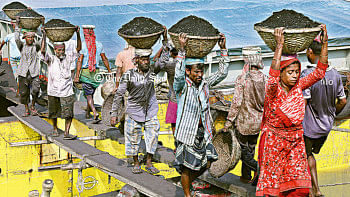A reckoning is due for Dhaka Wasa

Dhaka is witnessing an early diarrhoea outbreak this year. The hospitals in the city, including the International Centre for Diarrhoeal Disease Research, Bangladesh (icddr,b), are treating hundreds of new patients every day. As many as 1,200 patients visited icddr,b alone on March 26. A report published in this daily on Thursday said 57 diarrhoea patients had been admitted to icddr,b on average every hour in the previous 24 hours.
The staggering number of diarrhoea patients has caught the hospitals off guard. "In my 36-year-long career, I have never seen so many diarrhoea patients," Dr Tahmeed Ahmed, executive director of icddr,b, said when speaking to this daily last month.
Cross-contamination of the water supplied by Dhaka Water Supply and Sewerage Authority (Wasa) has been cited as one of the major reasons behind this diarrhoea outbreak. The mustard, greenish colour of tap water in the affected areas, along with the stench, suggests contamination with sewage water. And this possibility cannot be ruled out, because often when old pipes are replaced, due to negative pressure, sewage water gets into the main water pipelines, resulting in cross-contamination.
This is not the first time that Bangladesh has suffered a diarrhoea or cholera outbreak. Every year, these water-borne diseases come back to haunt the citizens during summer. A 2018 World Bank report suggested that 80 percent of the people who use supply water face the risk of E. coli contamination. And 92 percent of Dhaka's population drink water from contaminated water sources—mostly carrying E. coli—due to sanitation problems and industrial pollution of water.
Unfortunately, the Dhaka Wasa authorities seem reluctant to even acknowledge these issues. One would remember the remark by the current Wasa MD in 2019 that the water they supplied was 100 percent drinkable. He later refused to drink a glass of lemonade offered to him by a family from Jurain, made with Wasa water. One cannot blame the Wasa chief, because the yellowish colour of the water would not seem drinkable, yet a segment of Dhaka residents has been forced to have it because of the inefficiencies and laziness of the water authority. Recently, however, the Wasa MD once again claimed that 95 percent of the water supplied by them was pure which, apparently, only got contaminated because of leaks in the pipelines.
Dhaka Wasa is so indifferent to people's suffering that, despite being aware of the poor quality of the water they supply, they have done little to fix it. Take the case of Jatrabari, for example. In 2019, water samples from Jatrabari was tested by the LGRD ministry, and the result revealed that the water was contaminated with coliform and heterotrophic bacteria. But little has been done to remedy the situation in Jatrabari since then.
Dhaka Wasa's inefficiencies are hurting not just the consumers, but also the national economy, and it is creating a negative footprint on our SDG attainment agenda. According to a 2019 Transparency International Bangladesh (TIB) revelation, 91 percent of Dhaka households burn 363.7 million cubic metres of gas every year to boil water supplied by Dhaka Wasa to make it drinkable. The financial cost of this amounts to more than Tk 332 crore annually.
Constant and repeated requests for project deadline extension and additional funding is another key characteristic of Dhaka Wasa. Even the projects that it has been able to complete since 2009 have done little to address the problems such as contaminated water and waterlogging. Although Dhaka Wasa spent Tk 7,205.49 crore on various megaprojects since 2009, they have not been able to make any positive impact on the quality of their services (New Age, August 8, 2020). And for obvious reasons, suggestions of systemic corruption have surfaced from time to time.
At this point, one is forced to ask: Why do the Dhaka Wasa authorities increase water tariff so frequently? According to media reports, it has increased water tariff 15 times since 2009. Why do people have to pay more every year to drink contaminated water? Even this year, Dhaka Wasa has proposed a tariff hike of 20 percent, which, if approved, will be effective from July 1. So, where is all the money going? The argument that Dhaka Wasa has to "beg" for money is incorrect, because according to its audited financial report, in FY2020-21, it registered a profit of Tk 49.6 crore with retained earnings of Tk 892 crore.
It is high time the authorities concerned looked into the misadventures of Dhaka Wasa and took steps to alleviate the plight of common people. Its constant shoddy performance points to internal systemic problems and corruption, which is taking a toll on the Dhaka residents as well as the national economy. The consecutive six-time appointment and reappointment of the incumbent MD—a move termed "questionable" by TIB—is a manifestation of the corruption eating at the heart of the organisation.
Dhaka Wasa officials and board members should also be investigated, and the activities of the agency, including the internal mechanisms, protocols and procedures, should be audited for compliance. And based on the findings, the system should be cleaned of corrupt, foul elements and revamped in order to make it efficient and effective. A complete overhaul seems to be the only way forward with Dhaka Wasa. Whether the authorities have the political will to drive this change is what remains to be seen.
Tasneem Tayeb is a columnist for The Daily Star. Her Twitter handle is @tasneem_tayeb


 For all latest news, follow The Daily Star's Google News channel.
For all latest news, follow The Daily Star's Google News channel. 



Comments